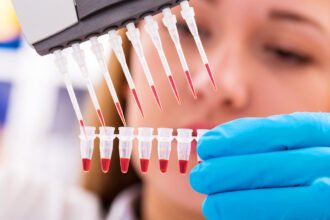Imagine a man with a recent severe heart attack who has the muscle repaired with stem cells or a child with a severe bladder defect repaired with stem cells grown on a biodegradable scaffold. Sounds like science fiction but these are actual clinical studies in progress today.
Stem cell therapies promise to be one of those scientific breakthroughs that will have an enormous impact on health care in the future. Stem cells will bring us closer to the goal of personalized medicine, just as genomics is doing. The course of a disease will change once we have the technology to develop and then insert stem cells into the human body to actually create a tissue. For example, a person with a heart attack will not go on to live the rest of his or her life with damaged heart muscle and resultant heart failure. Instead, stem cells will repopulate the heart muscle and make it whole again. Similarly, a person with Parkinson’s disease will recover full faculties thanks to the ability of stem cells to regenerate the damaged area of the brain. The person with type I diabetes will be free of the disease because of the formation of new pancreatic islet cells. The athlete will play again because new cartilage will be created for the worn knee. This is the promise of “regenerative medicine.” I have written the above as though each will definitely happen, a promise that will be kept. They probably will, but it may be a long time before the science of stem cells is sufficiently developed that these types of incredible results will be commonplace.
Adult stem cells are being used today for treatment of a few diseases and there are studies ongoing and planned for many additional possibilities. Let’s consider a few of them. Each of our tissues has a population of cells that can divide as needed to keep the organ or tissue functional as cells die or are injured. We see this with our skin as it constantly lays down new cells which make their way to the surface as the dead cells on the surface are rubbed off in the shower. We also see it when we cut ourselves and yet in a few days the wound is completely healed – that was stem cells at work. It appears that essentially every organ has its own pool of such cells. There are cells in the bone marrow that can become stem cells for many different tissues. These cells circulate in the blood and can be called to assist a tissue or organ to rebuild itself after injury or damage. So for example, if a surgeon takes one half of a father’s liver for transplantation into his son, we know that the father’s liver will grow back to normal size within about 6 to 8 weeks. Some of the stem cells will have been those already in the liver but some will have come from the blood stream to assist. Of course, the liver is the exception to the rule that if a portion of an organ is removed by trauma or surgery, it will not grow back. Cut off your finger and stem cells will help it to heal but not to grow back to its original state.
Adult stem cells are the ones used for treating leukemia, myeloma and other cancers and for correcting certain childhood immune deficiencies. Most often is the use of allogeneic hematopoietic stem cell transplantation, meaning the use of stem cells obtained from a closely matched individual. An identical twin is ideal but few have such a potential donor. Only 25% of siblings will likely match completely. This leaves the use of the National Marrow Donor Registry to find as close a match as possible from unrelated individuals. The Registry has markedly improved the chances for a close match and thus for successful transplantation outcomes. Many parents are now having umbilical cord blood saved and frozen to have available in the unlikely event that their child requires a transplant many years later. Although these cells are identical they usually are not sufficient in numbers to lead to engraftment and often the white blood cells (neutrophils) recover only very slowly leaving a prolonged period of infection risk. Perhaps a technique will be found to get the umbilical stem cells to multiply in the laboratory so that a larger number would be available.
Adult stem cells are being used in studies of myocardial infarction and heart failure. Current guidelines of immediate angioplasty and stent insertion as appropriate help protect the heart from permanent damage after an infarct. Still, about 400,000 new cases of heart failure are developing in the USA each year. Long term survival is limited once overt failure develops. Could the damaged heart muscle be fixed? The concept is to use stem cells to repopulate the muscle fibers and to have those cells divide over and over and differentiate into new muscle fibers or perhaps also the small vessels that carry blood to the muscle cells. So far there are some exciting animal studies and even some trials in patients that are encouraging enough to warrant further evaluations. For example, one studyuses adult mesenchymal stem cells derived from the bone marrow and infused intravenously within 7 days after a heart attack. 42 centers are collaborating in this double blind, randomized trail in conjunction with Osiris Therapeutics. 220 patients will receive either the stem cells or a placebo and then be monitored with various imaging and functional studies. So, stay tuned.
Another common albeit less lethal problem is loss of bladder control leading to incontinence. There are studies in progress to determine if stem cells placed into the bladder’s sphincter muscle will help it regain control. The adult stem cells are obtained from a leg muscle biopsy. Stem cells are isolated and allowed to grow in tissue culture. These are then injected into the weakened bladder sphincter muscle. Once again, these are studies just beginning but with intriguing early results.
Here is another bladder repair concept. When the bladder muscle is weak or largely missing in children it may be possible to literally rebuild the bladder by tissue engineering. A biopsy of the bladder yields cells that can be grown in the laboratory to large numbers. They can then be placed on a biodegradable scaffold and grown further. In time they seem to create a new bladder muscle wall complete with blood vessels. This layer of cells can be implanted in the bladder of children with a defect. Once more I need to note that it is still early days in these studies but they do raise exciting possibilities.
The message here is that adult stem cells are being used today for life threatening and life impairing diseases with excellent success and are being studied in other diseases with exciting prospects for the future.








